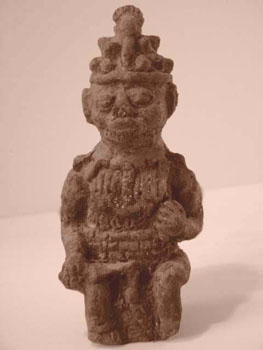The madman's smile
The relationship between conjuring and magic
For some time now, mentalism
and 'bizarre magick'
have been giving off a kind of sulphurous stench in the world of
conjuring - and sometimes rightly so.
Born out of the attacks against fraudulent spiritualism (by Houdini
and others), the movement to reject these forms of conjuring continues to
this very day, with crusades against Uri Geller, bogus mediums
and so on. While it is clear that in our so-called civilised societies
there are abuses of this kind, and that all abuse deserves a reaction, one cannot help but wonder whether some of the
approaches are simply unjustified.
In almost every case, the conjurer who bad-mouths
someone on TV has no other goal but to get himself a bit of free
publicity. He will usually be a former celebrity trying to make a comeback or an
incompetent phoney who cannot find any other way to earn the respect of
his colleagues at the office.
He patiently tells us that, while we the viewers are ultimately stupid, he
is privy to 'the Truth'. In my position as Curator of the Museum of
Supernatural History, I have on occasion had the opportunity to watch
remarkably incompetent demonstrations of magic by mediocre magicians
who, funnily enough, also just happened to be president-for-life of
some magic
club in Paris or Brussels.
Unfortunately for these learned individuals,
there are other links between the techniques of conjuring and
traditional forms of magic that do not include outright fraud. Far
from it.
For instance, the Indian rope trick is derived from two shamanist
rituals linked to Tibetan Bonpo Buddhism,
which is itself related to Hinduism. It is a theatrical expression of
the Buddha's ascension to heaven and the destruction of the self by
the demons of illusion. For further information on this subject, read
Shamanism by Mircea Eliade, as well as anything by Joseph
Campbell.
In the Tlingit and Kwiakutl traditions - two Native American tribes - there are 'trick' masks
which change appearance during sacred dances. The mechanisms used to
open the doors to temples in antiquity and the trickery and
ventriloquism used in certain voodoo divinatory rituals share this
approach.
Attempting to have participants perceive the beauty and power of the
invisible, having them feel emotions linked to self-transcendence (read
Voodoo by Gert Chesi). The term 'charlatan' as used in West
African voodoo does not have a negative connotation.
These illusions have their roots in the magical theatre, as does ventriloquism.
Creating an emotional shock shakes the foundations of our belief
system and makes us challenge our very senses.
The magician as Trickster is a figure who we have tried to highlight
through a number of shows, with a view to bringing some kind of
meaning back to the art. Eugene Burger
and Bob Neale offered their initial thoughts on the Trickster in Magic and
Meaning (published by Hermetic Press).
The Trickster is the chaotic divinity par excellence. He is both
benevolent and malicious, the guardian of order and the trouble-maker,
the man-god and god-man, a mediator between heaven and earth. He can
make fun of himself and be extremely serious. He can die, travel to
another world and come back to life as a fabulous teller of tales. He
is crucial to the development of a society, for without him a society
dries up, stiffens and dies.
 He is
known as Eshu amongst the Yoruba (as well as Legba and Exù), Loki amongst the Scandinavians
and as the spider Anansi in parts of the West Indies. He also goes by
the name of Coyote, Brer Rabbit, Shawnodese and Raven. The Romans
called him Mercury and the ancient Greeks named him Hermes (anyone interested in
'hermetic' science
would be advised not to forget this essential aspect of his personality).
The Trickster is seen in the
Harlequin, Punch and Judy, Qatu (amongst the Melanesians),
the Fool from the tarot cards, Shakespeare's Puck, the messenger of Oberon,
Satan and even Bugs Bunny.
He is
known as Eshu amongst the Yoruba (as well as Legba and Exù), Loki amongst the Scandinavians
and as the spider Anansi in parts of the West Indies. He also goes by
the name of Coyote, Brer Rabbit, Shawnodese and Raven. The Romans
called him Mercury and the ancient Greeks named him Hermes (anyone interested in
'hermetic' science
would be advised not to forget this essential aspect of his personality).
The Trickster is seen in the
Harlequin, Punch and Judy, Qatu (amongst the Melanesians),
the Fool from the tarot cards, Shakespeare's Puck, the messenger of Oberon,
Satan and even Bugs Bunny.
He is the origin of the sacred clown, the Heyoka Wakan of the Dakota
Indians, who talks and moves backwards. He is the proto-ancestor of the
clown proper.
The Trickster is not a formless 'entity', but takes the form of
certain individuals. Examples include Joseph Grimaldi
(1779-1837), considered to be the first modern clown in our culture, Tex Avery,
'Bob' Dobbs of the Church of the Subgenius, Ricky Jay, Jean Merlin,
Jerry Sadowitz, Anton Szandor La Vey, founder of the Satanic Church,
as well as Belgian cream pie thrower Noël Godin, with his pastry-fuelled
attacks.
The Trickster is always a frenzied individualist who views
institutions as alien entities, even though they are not
necessarily negative. He appears in countless disguises. He is generally hated by those who
'hear no evil', while he is loved by others. But he leaves no one indifferent.
In almost all cases, his most formidable weapon is humour, even if it
is sometimes acerbic and cruel.
Wise Men and Tricksters are often linked to each other. Mulla Nasruddin
in Sufi mythology is a perfect example of the fusion of these principles.
Returning to Uri Geller, he certainly gave us much to think about
with respect to the seriousness of scientific thought and certain
magicians.
Every society creates the Trickster that it needs.

